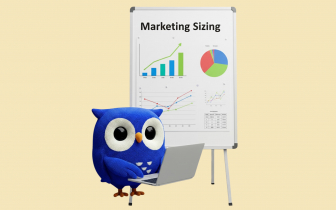B2B Content Marketing: How to Navigate in 2024

It’s impossible to skip content marketing activities if you work online. B2B content marketing might need preciser attention as we believe it to be more challenging.
So, what’s on track with B2B content marketing in 2024?
B2B companies seem to highly value content marketing activities; 43% plan to increase their content marketing budgets. Also, the use of content brings benefits as global content marketing revenue keeps growing from $72 billion in 2023 to a projected $107 billion in 2026.
Getting quality leads remains the main goal B2B content marketers have. Yet, creating the right content is a big challenge for this type of company.
But that’s only a few outtakes. What are other challenges B2B professionals face? What content types to use? The list goes on and on.
We collected the freshest data and insights from the reports by respected Content Marketing Institute (B2B Content Marketing Benchmarks, Budgets, and Trends: Outlook for 2024*) and Statista (Content Marketing Trend Study**) to help you navigate in content marketing in 2024 and build a better strategy for your company.
Main B2B content marketing challenges
Content marketers can face various obstacles while building a content marketing strategy. Here are some examples to give you a clue.
Compare the experience of your colleagues, check what you are missing, and see how you might change this.
Content creation challenges
Content creation is not a walk in the park. If someone doesn’t work in this industry, it might sound odd to them. What’s difficult in posting a meme? Sharing a one-minute video? Pfffff… Not that difficult.
But the reality is very different.
Moreover, even if you have worked in B2B for a long time, you might find some eye-opening predictions in this section! (We highlight it, no worries.)
Nevertheless, let’s start from the very beginning.
57% of marketers* share that creating the right content for their audience is challenging.
Consistency, differentiation, and optimization for SEO are the next biggest content creation-related problems.
And that’s what you should pay close attention to. Google emphasized content importance and helpfulness in its latest update. Creating content that doesn’t match users’ needs can harm your content marketing strategy.
Appearance and fast development of AI tools (especially for marketing needs) are awesome, for sure. Yet, you shouldn’t pin your faith on them fully. That might be a trap.
Producing huge amounts of AI-generated content that even matches your clients’ interests is not the best decision. Work smarter!
Lean towards creating original content that provides your expertise, experience, and insights and addresses customers’ problems.
And now, get ready for an eye-opening insight!
Be ready to make your B2B content marketing strategy less boring and official. Younger generations are the biggest cohort of the population. For instance, there are 72.19 million millennials and 68.6 million Generation Z in the US. These generations will complete the majority of the working force.
So, be set for revising your strategy and winning their attention.
Non-content creation challenges
Another palpable obstacle professionals face is a lack of resources (58%)*. And we can feel their pain. According to multiple sources we’ve seen, content marketing (or even marketing) teams consist of one to five members.
Add to this content alignment with the customer’s journey (48%) and content effort alignment across sales and marketing (45%)* - and that can make your head go spinning.
Can you change this?
Well, we advise you to refer to special AI-based tools. (Yes, we’ve told you not to abuse AI too much, specifically in content writing.)
But smart use of AI tools can save you time, understand users’ journeys better, offer better personalization, and lots more. There are lots of advantages of using AI in marketing, to be honest. You only need to know what tools to choose and how to use them.
Besides this, the majority of B2B marketers (67%)** want to publish content more often. However, various reasons prevent professionals from doing this. And lack of time is the main ground.
Once again, the smart use of AI-based content marketing tools can ease your life. So, don’t be afraid to test and try something new to optimize your process.
The most common B2B content types used
What content formats are the most popular in the B2B niche?
The majority of them will align with the formats generally used across different business types - mainly text-based formats, videos, or infographics.
As sources we’ve used (CMI and Statista) might use various audiences (yet, working in B2B) and methodologies, the numbers might differ. Also, take into account that CMI provides fresher data. However, let’s see if the content types (from most to least popular) concur.
Firstly, let’s refer to CMI*. According to it,
- 94% of B2B professionals prefer short articles/posts (89% last year),
- 85% use videos (75% last year),
- 78% of B2B marketers utilized case studies/customer stories (67% last year).
This way, the top three used formats are text-based content, videos, and text-based content once again.
Next thing, let’s refer to Statista**. As it reports,
- 79% of B2B content marketers preferred text-based formats in 2023 (60% in 2022),
- 66% used video formats in 2023 (69% in 2022),
- 57% of B2B specialists preferred infographics in 2023 (57% in 2022).
This way, the top three used formats according to Statista, are text-based content, videos, and text- and visual-based content.
Once again, the first two content types stay similar for CMI and Statista. The tendency shows its continuity - from 2022 to 2024.
Yet, we notice some differences if we continue to the less-used formats. CMI doesn’t highlight webinars at all.
From our point of view, this can be a fitting format in B2B. You can share your expertise, give value, and educate your audience through this content type quite effectively. Besides, webinars allow you to communicate with your audience directly.
Studies and customer stories are in third place in the CMI research and only on the eighths in the Statista’s. We would like to stand out this content type. As B2B operations are usually more complex, case studies and stories can help clients understand B2B company’s products or services better.
Real examples can show how your firm helps, what pain it solves, what solution it offers, and how it can make client’s business better.
The following statistics by CMI* only prove our point of view. As such, 53% of B2B professionals share that case studies were the most effective content format.
So, don’t hesitate to reach out to your clients to work on success stories with them. Don’t be afraid to give a sneak peek at your solutions and show how they help using real examples.
Ways of content distribution
After you’ve figured out what content type is better to employ, it’s time to decide what distribution channels to use.
If we speak common terms, the prevailing number of B2B content marketers use owned media (70%**) for these purposes.
That means the majority of marketers use their own blogs, social media accounts, email newsletters, and other owned channels to share content.
Reports provided by the sources we use in this article agree on top distribution methods, which are
- Company’s blog,
- Social media,
- Email newsletter.
Still, some differences are evident between those sources if we take a broader look at this point.
For instance, the third most used distribution channel, suggested by Statista, is SEM (52%**).
Statista does not highlight blog as a separate distribution option. Most probably, they consider this channel within the “lead generation via in-house channels” group.
Yet, what’s interesting, this source stands sponsored posts out. We agree with this way of content distribution. If you choose partner sites or blogs correctly, you can get leads closer to conversion (as they are already interested in your products). The best way to boost your sponsored post activities, is to use some help from a guest posting service.
Anyway, what distribution channels does CMI suggest?
Except for social media, newsletters, and blogs you’ve already heard of, you can also create webinars, run digital events, or host podcasts.
Do you remember we’ve told you about webinars in the previous section? As you can see, it’s two-in-one: a type of content to use and a way to share it. Moreover, you can save the webinar and post it on your YouTube as a long video or use it for YouTube Shorts or Instagram Reels.
If we refer to paid distribution channels, we will notice that SEM is equally praised by CMI and Statista. That said, Content Marketing Report* shares that:
- 78% of B2B marketers use social media advertising/promoted posts,
- 65% of professionals use sponsorships,
- 64% of specialists use search engine marketing (SEM) or pay-per-click.
Moreover, 62% of B2B content marketers* claim that SEM was the most effective paid distribution channel.
A significant difference between B2B and B2C marketers lies in what social media platforms they use to distribute their content. When we think of someone who works in B2C, platforms like Instagram, TikTok, and YouTube easily pop into our heads. But what about B2B?
B2B content marketers have shared what social media platforms offer the most value to them:
- 84% claim LinkedIn to be the best channel,
- 29% cite Facebook as a top performer,
- 22% say YouTube is acting good for them.
But would you like to know how your colleagues actually used social media during the last year? Here you go:
- 72% of respondents increased LinkedIn use,
- 32% of marketers increased YouTube use,
- 31% of professionals increased Instagram use.
What’s curious - 81% haven’t used TikTok at all.
B2B content marketing teams
How many human resources do B2B companies usually allocate to content marketing needs? As we’ve mentioned earlier, most team consists of one to five team members. Statista shares the following data**:
- 27% of B2B firms have one person,
- 58% of B2B firms have two to five people,
- 7% of B2B firms have six to ten people,
- 3% of B2B firms have 11 to 25 people,
- 3% of B2B firms have 26 to 5o people,
- 1% of B2B firms have 50+ people,
- 2% of B2B firms have no content marketing team.
As you can see, content teams are quite compact in the B2B segment. And just imagine how overloaded they can be if 51%* of larger B2B companies (100+ employees) request content creation through centralized content teams.
Though some departments produce their own content (23%*), it’s logical that the majority of companies prefer content marketing teams to curate content. We agree with this approach, as every employee/department should engage in their professional activities. That said, the content marketing team crafts all sorts of content, and let’s say the IT department involves in IT matters only.
But what if your team does not have enough capacity at some point in time? Well, sometimes it means you need to grow your department. Normally, it’s applicable when your whole company is growing.
Yet, if the demand for content is seasonal, for example, you can outsource some content marketing activities.
According to CMI*, 3% of B2B companies outsource content marketing activities to one or more agencies.
And, as Statista** reports, 69% of content marketing teams outsource, particularly content creation.
That is a pretty logical and budget-friendly decision if you choose a reliable content creation agency.
How B2B content marketers use AI
It’s impossible to skip AI in 2024. So, of course, we will discuss this matter and the B2B sector's attitude to it.
As a matter of fact, only 28% of B2B marketers** say AI tools are important to them (compared to 53% of B2C professionals.)
We can understand this, as AI (in general) is a new thing. It’s not always clear how to use it, what results it can bring, and what hidden hazards it can bring.
Yet, if we talk specifically about generative AI use, 72% of CMI’s respondents* shared that they employ it.
If we take a deeper look at ways of genAI use*, we see that:
- 51% of B2B content marketers utilize it for brainstorming new topics,
- 45% of B2B content marketers utilize it for headlines, keywords, etc., research,
- 45% of B2B content marketers utilize it for writing drafts.
To be fair, we are happy to see exactly these three main directions in generative AI use. That’s how smart tools can save the content marketing team’s time and optimize processes.
Topic ideation, research, and article drafting won’t harm your content and its position in SERP.
But if you use AI-based tools to fully write your content we highly recommend you stop doing this. That might decrease your SERP positions. Search engines value original content and can detect AI-generated texts.
What has surprised us is that 61% of B2B companies* have no guidelines on genAI use.
We think that it’s a smart idea to create internal guidelines on the genAI-based tools for the team. In fact, lack of training is one of the main reasons (27%*) preventing marketers from using AI.
That’s why arranging time for learning more about AI tools, and writing a guide for your team is what you should do this year to optimize your work.
B2B content marketing budgets
And last but not least, it’s time to discuss content marketing budgets in the B2B segment.
As content plays an important role in today’s company promotion, it’s interesting to see how many funds firms allocate for this activity.
According to Backlinko,
- 9.7% of B2B product companies spend their overall budget on marketing,
- 7.2% of B2B services companies spend their overall budget on marketing.
Around 29% of B2B marketers* share that 10% to 24% of the marketing budget goes to content marketing.
However, according to the joint information from the main resources we use, content marketing budgets continuously increase.
45% of B2B content marketers* plan to increase their budgets in 2024.
Though the budget growth is not that considerable (the majority of firms increase it by up to 9%), it’s still a sign that content marketing plays a vital role in modern company’s promotion.
Right now, let’s see how content teams plan to allocate those budgets.
Both Statista and CMI share that the top three investments in 2024 are:
- 69% - video content,
- 53% - thought leadership content,
- 47% - in-person events.
It seems like 2024 will be the year of video content. But that’s not too surprising.
As we’ve written earlier in this article, soon (and partly now), Millennials and Gen Z will be the main target audience, even for B2B.
And as this content type is most preferred for them, make sure you produce enough visual material. Gladly, there are enough AI-powered video tools to help you out.
Conclusion
So, how can we sum up all the data and insights we’ve shared in this article?
B2B content marketing in 2024 won’t significantly change from the past year. Yet, creating the right content should remain a priority for professionals. That’s particularly essential given Google's latest content guidelines.
Don’t forget to try formats that professionals believe to be the most effective - case studies and videos.
Also, don’t be afraid to try something new - study how generative AI tools work and how they can optimize content marketing processes for you.
If your company is armed with enough budget and you know how to use it efficiently, increase your content marketing spending.
How are your content marketing efforts doing? Do you find it harder to craft a worthy strategy for your B2B this year than in previous ones? Leave your comments below, and let’s talk!







